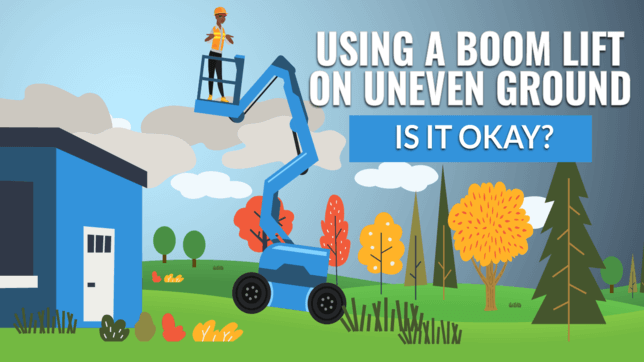This article answers the question: Can you use a boom lift on uneven ground?
Besides boom lifts, we’ll also cover using scissor lifts on slopes.
Plus, lots more…
Let’s dive in!
Why Is it Dangerous to Operate a Boom Lift on a Slope?
You might be wondering: Can boom lifts tip over?
Answer: Yes, especially if you use one on a slope that exceeds the boom’s gradeability or chassis angle limit.
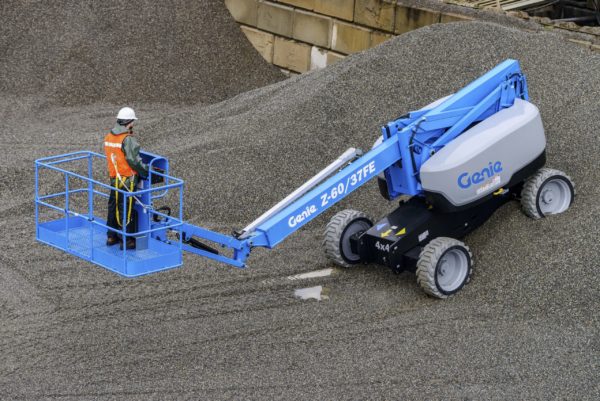
And that is the main reason why operating a boom lift on a slope is dangerous.
In fact, tip-overs are responsible for one-third of boom lift accidents according to the Electronic Library of Construction Occupational Safety & Health.
Besides tip-overs, there are a couple other slope dangers, including:
-
Slopes reduce traction, leading to slippages
-
Slopes extend the stopping distance, making braking harder
These risks are why OSHA requires that aerial lift operators recognize and understand the hazards associated with using the equipment.
That way, operators can ensure they eliminate or work around them.
What Exactly Is a “Slope”?
Mathematically speaking, a slope is simply any surface with an incline.
So any time an aerial lift is not on perfectly level ground, it’s technically on a slope.
Thus, slopes include not only ramps and hills but a variety of other surfaces like raised sidewalks and uneven gravel.
Can You Use a Boom Lift on Uneven Ground?
Let’s unpack this question a little bit.
The word “use” can mean two different things with boom lifts:
- Driving
- Raising or extending
So the answer to this question depends on which sense of the word “use” is meant.
Driving on Uneven Ground
If you’re talking about driving your boom lift on a hill, you can…
Provided that the platform is fully lowered and you don’t exceed the manufacturer’s gradeability limit.
How do you know what the gradeability limit is?
Check the identification plate installed on the lift.
You can also find it in the operator’s manual.
Raising or Extending the Platform on Uneven Ground
This is practically universally prohibited by manufacturers.
In fact, Genie, JLG, and Skyjack each clearly restrict doing so in their owner’s manuals.
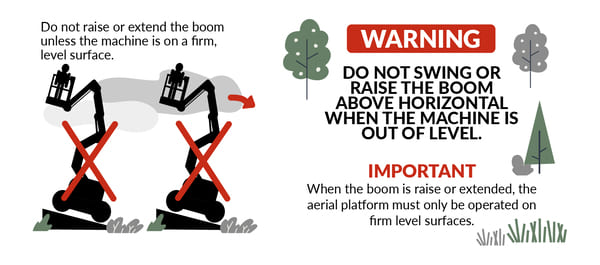
This is because raising the boom on a slope can easily cause the lift to topple over.
The exception to this rule is boom lifts with outriggers.
These machines are designed for uneven surfaces since the outriggers provide a way to level the lift and thus elevate it safely.
We’ll discuss outriggers in more detail in the section below called “What Should You Do When Your Aerial Lift Can’t Handle a Particular Slope?”
What Type of Boom Lift Can Be Used on Uneven Ground?
A rough terrain 4×4 boom lift for uneven ground is a good option for driving on slopes.
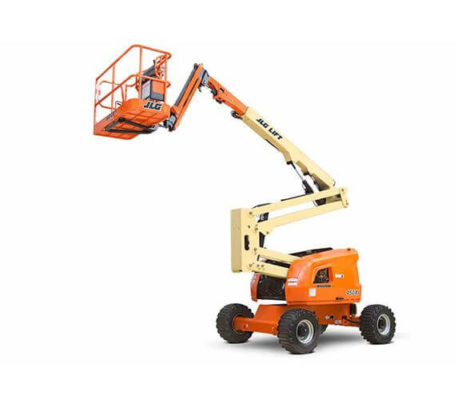
These all-terrain boom lifts are equipped with pneumatic or foam-filled tires and powerful engines.
This combination helps them traverse uneven ground and slopes better than other types of boom lifts.
Can I Use a Scissor Lift on a Slope?
The rules for operating a scissor lift on a slope are the same as using a boom lift on a slope.
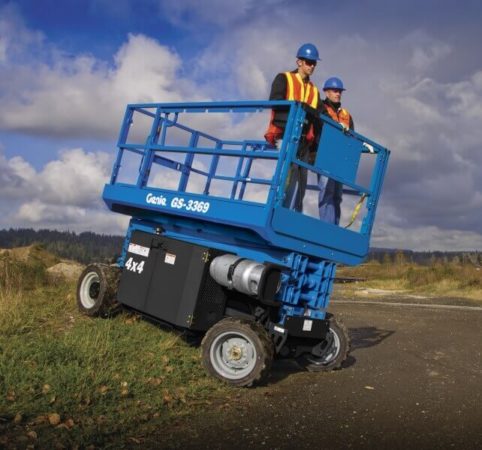
Just to review, you can drive a scissor lift on a slope – provided you don’t exceed the manufacturer’s gradeability limit.
But you cannot raise the platform of a scissor lift on a slope.

Genie, JLG, and Skyjack each – respectively – prohibit elevating a scissor lift on uneven ground
How Hard Is it to Tip-Over a Scissor Lift?
It’s hard to tip over a scissor lift if you follow the manufacturer’s limits.
And that means not elevating on a slope and staying within the side force limits.
But it’s easy to tip one over if you disregard these rules.
Gradeability and Chassis Angle Limits: What’s the Difference?
We’ve mentioned “gradeability” in the previous two sections.
This is an important term in the context of operating boom and scissor lifts on uneven ground.
But it’s often confused with chassis angle limits.
So, what’s the difference?
Boom lift gradeability refers to the ability of the lift to travel over an incline while stowed and traveling in a specific direction.
The chassis angle limit, on the other hand, is how much of an incline the aerial lift can elevate on.

Now, we’ve already said that elevating on an incline is prohibited in most cases.
But if your lift does allow it, it’s important that you don’t confuse these two terms.
Otherwise, you can end up with a lift that won’t do what you want it to.
Or worse, you could end up tipping the lift over.
Aerial Lift Slope Warning Systems: What Are They?
Many aerial lifts have slope sensors.
These are usually located in the base frame, near the ground controls, or on the turntable.
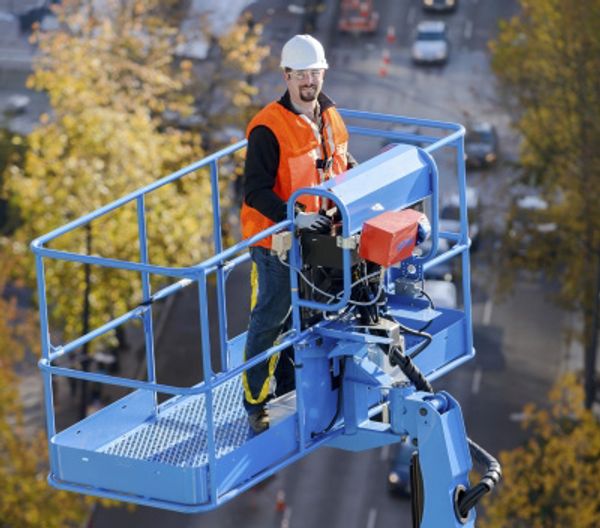
What do these slope sensors do?
If the lift is used on a slope exceeding the machine’s limit, an alarm will sound to alert the operator.
When that happens, the platform must be lowered and the lift must be re-positioned on a surface that is within the safe working angle allowed by the manufacturer.
Your lift’s owner’s manual will provide the exact steps for doing so:
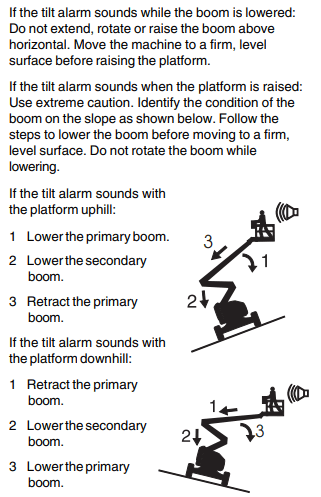
The problem is that, in the past, these warnings were more of a “suggestion” than a mandate.
That is, operators weren’t always actually prevented from further operating the lift.
But recent changes made to ANSI A92 specify that manufacturers must provide a means to automatically shut down the lift’s functions if the slope rating is exceeded.
In that case, the operator can only move the lift away from the trouble area.
In doing so, ANSI’s updated standard improves safety by eliminating the option for the operator to continue working on unsafe terrain.
So if your Genie boom lift won’t drive or your Genie scissor lift will not move, a good thing to check first is that you’re not on a slope that exceeds the lift’s limits.
How to Tell If You Can Drive an Aerial Lift on a Particular Slope
Recall that you usually cannot raise or extend a boom arm or scissor lift platform unless the lift is on a level surface.
Thus, this section only explains how to determine if you can drive either a boom lift or scissor lift on a particular slope.
There are 3 steps in this process.
Let’s go through each in detail.
Step 1: Find the Slope Rating
You’ll first need to measure the slope in question to determine its grade.
There are 2 methods for doing this.
Method 1: Use an Inclinometer
This is the easiest way.
You can simply download this free app (iOS or Android) and use your phone to do it.
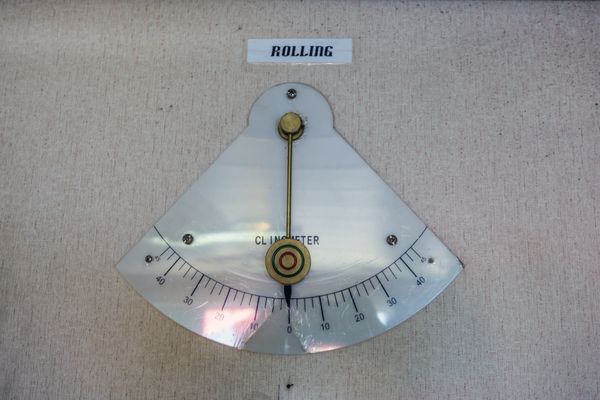
Just open the app, place your phone on the slope, and it will automatically calculate the angle for you.
Method 2: Measure it Manually
This method involves finding the rise and the run of the slope.
To do so, you’ll need a:
- Board at least 3 feet long
- Level
- Tape measure
Here are the steps for finding the rise and the run and converting that measurement to find the slope’s grade:
- Place the board on the slope
- Place a level on top of the board
- Lift the downslope end of the board until it’s level
- Measure the distance between the downslope end of the board and the slope surface (this is the “rise”)
- Divide that measurement by the length of the board (the board length is the “run”)
- Multiply the product by 100 to get the slope grade percentage
For example, let’s say you have a 36-inch long board.
You follow steps 1 through 4 and find that your rise is 6 inches.
Step 5 would be: 6 inches ÷ 36 inches = 0.16667.
And completing step 6 (0.16667 x 100) gives you a slope grade percentage of 16.667%.
Don’t Like Math?
Fortunately, if you don’t want to manually do this math, you can use this free grade calculator to do it for you.
Step 2: Find the Gradeability of Your Aerial Lift
Once you’ve determined the grade of the slope you need to traverse, you’ll next need to find your lift’s gradeability rating.
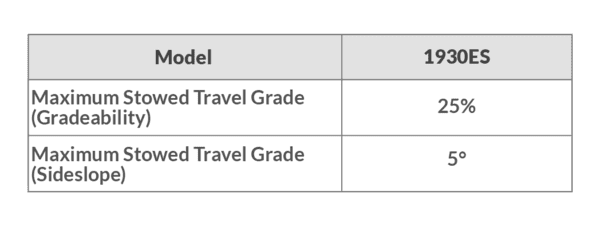
As mentioned, this can be found on the data plate or the operator’s manual.
Step 3: Compare the Slope Grade to the Machine’s Slope Limit
Take your two numbers (the measurement of the slope and your boom lift’s maximum slope).
If the slope is greater than the rating, do not drive the lift on the slope.
For example, let’s say you need to traverse an incline of 8% with a Genie Z-45 articulating boom lift.
After reviewing the owner’s manual, you find out that this articulating boom lift’s limitation for slopes is as follows:
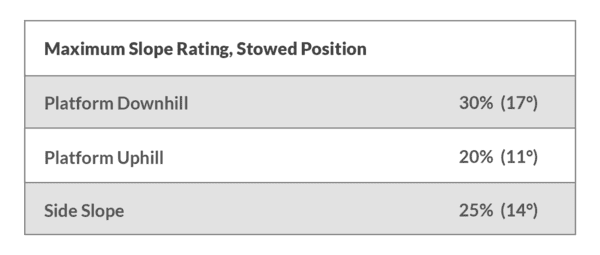
In that case, your lift can handle the incline.
But that’s not quite all…
Because you’ll also need to ensure the overall ground conditions and traction are acceptable.
What Should You Do When Your Aerial Lift Can’t Handle a Particular Slope?
You have a few options in this scenario.
Let’s go through each one.
Get a Lift With Greater Reach
For safety’s sake, it may be your best option to acquire a different lift for the job.
For instance, you may need to rent a larger telescopic boom lift that can reach farther out.
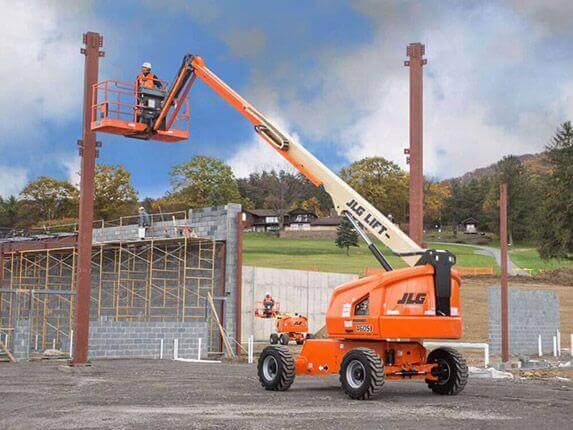
This can make it unnecessary to traverse the slope since you’ll be able to reach beyond it.
Use Approved Cribbing Material
This method involves creating a level surface for the aerial lift to operate on.
So if you’re wondering how to level a boom lift, this can be one effective method.
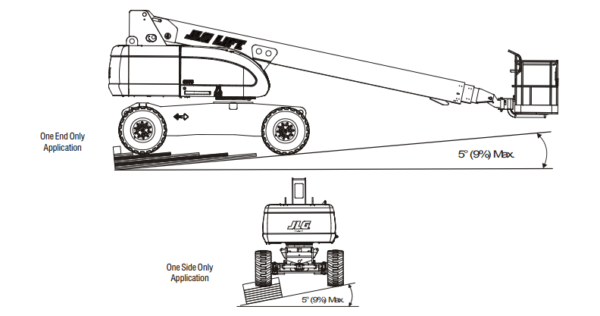
Again, you should refer to the owner’s manual to determine if your specific lift can work with cribbing and what the specific instructions are for how to construct the cribbing.
For instance, Genie and JLG both offer supplemental cribbing instructional manuals.
You can view Genie’s here and JLG’s here.
Then, build your cribbing material to comply with it.
Use Outriggers
If you have a scissor lift or boom lift with outriggers, you should use them.
That’s because the outriggers allow the machine to be leveled on uneven ground.
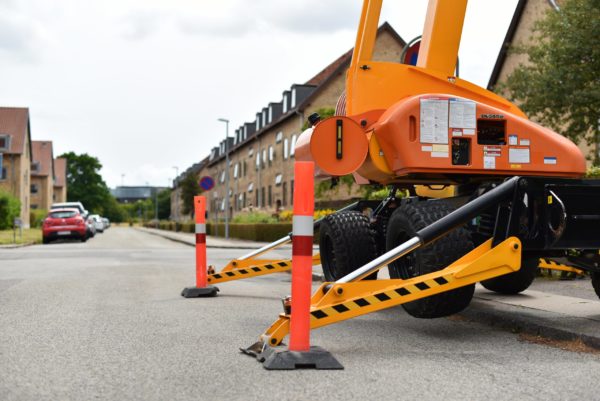
How does this work?
First off, self-leveling boom lifts exist which take care of this automatically.
For instance, JLG’s X500AJ tracked boom lift has this functionality.
To auto-level the boom lift, you simply press a button and the outriggers extend out until the lift is level.
But if you don’t have an auto-leveling boom lift, you’ll have to manually level the lift using the outriggers.
Then, you’ll check their level using the lift’s bubble levels.
If the machine isn’t perfectly level, you’ll need to adjust each outrigger until it is.
And as always, make sure you check the operator’s manual for specific instructions on how to do this.
Use a Winch or Material Handling Equipment to Move the Boom Lift
This method involves using a winch, forklift, or crane to traverse the slope.
If using the winch method, check your aerial lift’s manual for the proper procedure.
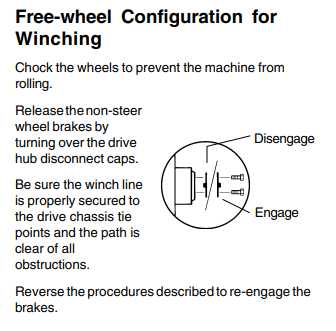
If using a forklift or crane, first check your boom or scissor lift’s data tag for the weight.
Then, compare it to the capacity of your chosen material handling equipment.
Finally, check your owner’s manual.
This should provide the proper procedure for lifting the aerial lift.
6 Tips for Safely Operating an Aerial Lift on a Slope
You’ve followed the steps above and can operate your lift on a slope.
Now, here are a few important tips on how to move a scissor lift or boom lift safely on uneven ground:
1. Perform the Required Pre-Start Inspection
These inspections help identify any deficiencies in the lift.
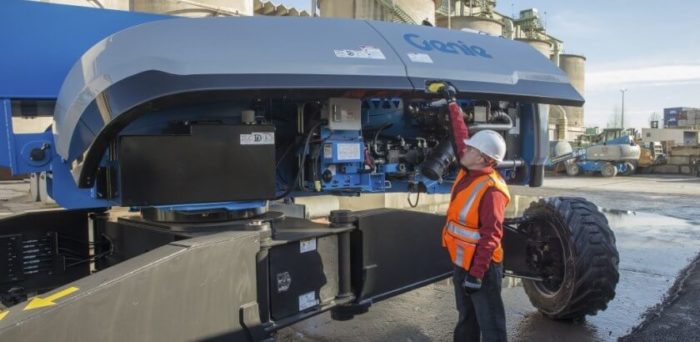
If you skip this step and operate on a slope, you greatly increase the risk of something bad happening.
Not to mention, you’ll also be in violation of OSHA, which mandates pre-start inspections.
2. Inspect Your Work Environment
This is part of the pre-start inspection.
Check for any defects in the work area and slope, like loose gravel, potholes, and ditches.
And ensure you correct these issues before operating.
3. Check the Tire Pressure
This can affect the stability of the lift if it’s not within spec.
Check the tire itself or the owner’s manual for the proper PSI for your aerial lift’s tires.
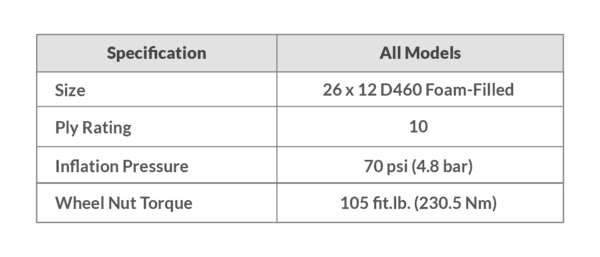
If they’re not inflated to spec, get them up to par.
4. Drive Slowly When Climbing or Descending Any Slopes
Doing so will give you more time to react.
And that will improve your safety as well as the safety of others around you.
5. Give Yourself Extra Distance for Braking
Slopes require a longer distance to stop your aerial lift.
Maintaining extra braking distance will help you avoid sudden stopping, which can eject you from the platform.
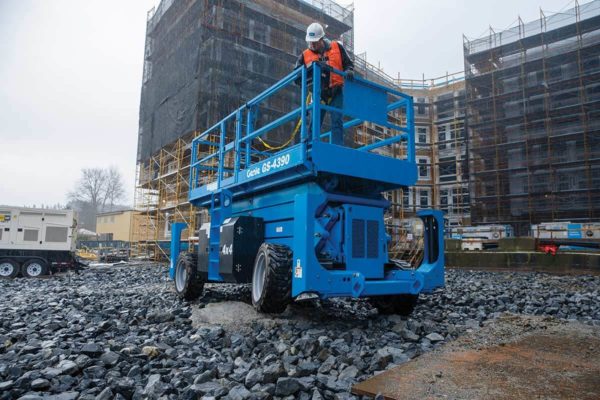
Additionally, you’ll have more time to react to obstructions in the way, like equipment and workers.
6. Use Outriggers When Possible
As mentioned above, these help to level and stabilize the lift on uneven surfaces.
And that helps reduce the chances of a tip-over when elevating.
Conclusion
Congratulations!
You now know if you can use a boom lift or scissor lift on uneven ground.
